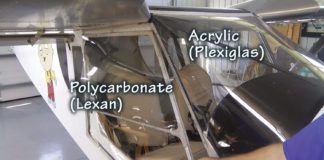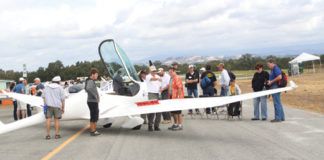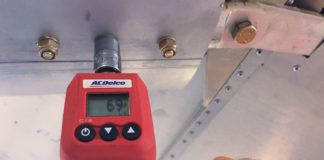Allow me two observations. First, these days its fashionable and prudent to be concerned about fuel efficiency; and second, there seems to be an increased interest among pilots in motorgliders. Cause and effect? Who knows? But many pilots say they are flying less because of the high cost of fuel. For those whose primary interest is getting somewhere quickly in style, the apparent solution is to either fly less often or fly at more economic airspeeds.
For some of us, though, flying-not some destination in the distance-is itself the objective. We recreational pilots have a lot from which to choose, and gliders are among the choices. And for those willing to sacrifice some soaring performance and money for broader capability, there are motorgliders, which are intended for both power-off soaring and constant-power cruising.
Meet the Lambada
For many, the January 08 Sebring LSA Expo was a first opportunity to check out the Urban Air factory-built Light Sport (SLSA) Lambada, an all-composite two-seat motorglider from the Czech Republic. Featuring an 80-horsepower Rotax 912 engine, the Lambada benefits from an FAA determination that its featherable two-blade Woodcomp propeller does not violate the LSA prohibition on variable-pitch props. Thats a necessary and reasonable interpretation, because glide performance depends on minimizing stopped-prop drag, and in the
power mode the pitch remains fixed.
The Lambada uses conventional sailplane controls: sticks between the knees, rudder pedals plus a spoiler lever between the seats. A steerable tailwheel and non-differential wheel braking via a bicycle-
grip handle on the left stick comprise ground-handling systems.
Josef Bostiks company, Bostik Industries of Melbourne, Florida, imports and services Lambadas, and testimonials on the company’s web site indicate that some early U.S. buyers love their aircraft and are pleased with company support.
All aircraft designs are compromises, but for at least one of them (optimize cruise or soaring performance?), the Lambada provides an interesting option included in the price. As in all aircraft, glide performance improves with higher aspect ratio (longer, smaller-chord wings for more of it). But higher-speed cruise performance can benefit from reduced wing area and resulting higher wing loading. Thats why airline pilots reduce wing area by retracting Fowler-type flaps after takeoff.
The Lambada solution to optimizing both missions (gliding and cruising) is to provide easily attached wing extensions for gliding. Wingspan without the tips is 43 feet (aspect ratio 13.9), and bolting them on adds an additional 6 feet (aspect ratio 17.4). The difference in glide ratio is significant, 26:1 glide for the shorter span and 30:1 for the long span. In still air, with the longer span, you could glide 30 miles before touchdown from an altitude of less than 5500 feet. The power-off minimum sink has been measured at 210 fpm, meaning that at minimum-sink airspeed-45 to 50 knots-you can glide in still air for nearly 5 minutes for each thousand feet of altitude.
Let’s Fly
Urban Air USA Sales Director Jim Lee and I lacked still air for our Lambada flight in the short-wing configuration. A cold front had ripped through central Florida during the night, leaving behind an 18-knot northwest wind for the Sebring LSA events final day. After the usual Rotax and walkaround preflight, I manned the right seat. Lee had the wheelbrake
handle on his side. Startup and taxi appeared easy.
Takeoff roll into the breeze was short, and climb was a solid 750 fpm behind the 80-hp Rotax 912UL. Flying solo with half of the Lambadas 26-gallon fuel capacity, the climb would be close to 1000 fpm. During our climb to 3000 feet, I found the Lambadas controls to be light and well balanced, as you would expect in any modern sailplane. My standard roll rate check-45 one way to the other 45-took about 3 seconds, which is fast for a big-span, wing-loaded aircraft like the Lambada.
Aileron trim was not perfect; we needed constant light right aileron pressure, which precluded doing my usual stick-free pitch stability check. A departure stall at 4500 rpm was at about 40 knots and docile. After simply releasing back pressure, we were flying smoothly again.
Visibility is terrific, and ventilation is excellent thanks to European-glider-standard sliding acrylic canopy panels with adjustable air scoops on each side.
Next I tried an approach stall, which was also gentle and occurred at 36 knots (far under the 45-knot LSA maximum). The slip-skid ball was in the center, and neither wingtip dropped as we stalled. Low cruise at 4200 rpm was pleasantly quiet. I removed my headset, and we could have easily heard each other at this power setting. Pushing power to the Rotax 912 time-limited redline level (5800 rpm for no more than 5 minutes) yielded 115 knots, which is the Lambadas Vne. Lee demonstrated something unusual: a full-power climb at 700 fpm with the spoilers fully up!
Glider Mode
Then the fun began as Lee secured the engine and feathered the prop. We removed our headsets and slid earthward at 55 knots, which is close to best glide speed (maximum L/D) in still air with the shorter-span wing, yielding a glide ratio of about 26:1. I sampled some steep and shallow turns, and found that the Lambada feels much like any high-performance sailplane in cruising flight. At 55 knots, we were sinking at nearly 400 fpm, which Lee said indicated that we were in a sinking air mass. Slowing to minimum sink airspeed (corresponding to max duration in an airplane) at about 45 knots, we saw a sink of about 220 fpm.
Trimmed for minimum sink, the Lambada glides quietly and handles well even with strong maneuvering. That characteristic is important in gliders, as pilots maneuver aggressively at minimum speed to find and maintain position in the best rising air. On this windy day under a stratus layer, we found no lift, so gliding was in and soaring was out. I pointed at the airport while at near 3000 feet and enjoyed a nearly silent glide. I used the slip-skid ball to stay coordinated, but Id have a yaw string on the canopy if the Lambada were mine. It would be useless with power on, but would seem natural and be considerably more sensitive than the ball for soaring and gliding flight.
Power On
Were down to 2200 feet, and its time to wake the engine, which wont start with the prop feathered. Moving the large red handle on the lower center console repitches the prop to the power position. Lee turned the battery master and ignition on, and the little Rotax started in a fraction of a second. Were flying an airplane again. Out quite a distance on final, I pulled the throttle to idle and landed with the spoilers fully extended (the spoiler handle between the seats was moved fully aft, the same direction you move the throttle for minimum power). Like a throttle, the spoiler handle can be modulated to stay on the glide path.
A little bounce, and we landed in not much more than 100 feet into the 18-knot headwind. Leave the spoilers up, Lee said, to prevent getting airborne again. Taxiing appeared easy, but you need to “fly” the airplane to its parking space in a wind like this. Also, even with the shorter 43-foot span, you must pay attention to obstructions such as runway signs. Steering is direct to the tailwheel with non-differential braking using a handgrip on the stick, and the turn radius is not small. With the longer tips, ground movement could be a challenge at some small airports. Out of the cockpit, maneuvering the Lambada by hand was not a problem despite the wind.
Late News
Company chief Josef Bostik says that by the time you read this, the standard Lambada will come with the 100-hp Rotax 912S instead of the 80-hp version, which will still be available by special order. My advice would be to stick with the less expensive, less thirsty 80-hp Rotax unless you plan to operate from high-altitude airports.
Urban Air USA was busy demonstrating the Lambada during all comfortable flying weather at Sebring, and many potential customers were no doubt experiencing their first “convertible glider” flights. For the joy of hundreds of power-off flying hours without the hassle and expense of pure (engineless) soaring, the beautifully built Lambada is an attractive option.
For more information including pricing, visit www.urbanairusa.com. A direct link can be found at www.kitplanes.com.




